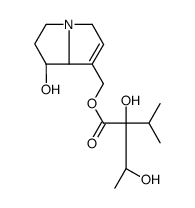10285-06-0
| Name | intermedine |
|---|---|
| Synonyms |
[(7R,8R)-7-hydroxy-5,6,7,8-tetrahydro-3H-pyrrolizin-1-yl]methyl (2S)-2-hydroxy-2-[(1R)-1-hydroxyethyl]-3-methylbutanoate
Intermedina [INN-Spanish] Butanoic acid,2,3-dihydroxy-2-(1-methylethyl)-,((1R,7aR)-2,3,5,7a-tetrahydro-1-hydroxy-1H-pyrrolizin-7-yl)methyl ester,(2S,3R) 9-(+)-Trachelanthylretronecine lycopsamine Intermedine Intermedinum [INN-Latin] [(1r,7ar)-1-hydroxy-2,3,5,7a-tetrahydro-1h-pyrrolizin-7-yl]methyl(2s,3r)-2,3-dihydroxy-2-(propan-2-yl)butanoate Intermedina Intermedinum |
| Description | (+)-Intermedine, a pyrrolizidine alkaloid (PA), exhibits significant cytotoxicity in neural progenitor cells (NPCs)[1]. |
|---|---|
| Related Catalog | |
| In Vitro | (+)-Intermedine (1.1-30 μM; 24 hours) exhibits significant cytotoxicity at 30 μM and reduces cell viability in a concentration dependent manner in neural progenitor cells (NPCs)[1]. (+)-Intermedine showsno differentiation impairment[1]. Cell Cytotoxicity Assay[1] Cell Line: Neural progenitor cells (NPCs) Concentration: 1.1, 3.3, 10, 30 μM Incubation Time: 24 hours Result: Exhibited significant cytotoxicity at 30 μM and reduced cell viability in a concentration dependent manner. |
| References |
| Density | 1.26g/cm3 |
|---|---|
| Boiling Point | 463.3ºC at 760mmHg |
| Molecular Formula | C15H25NO5 |
| Molecular Weight | 299.36300 |
| Flash Point | 234ºC |
| Exact Mass | 299.17300 |
| PSA | 90.23000 |
| Vapour Pressure | 1.57E-10mmHg at 25°C |
| Index of Refraction | 1.567 |
| RIDADR | UN 1544 |
|---|---|
| Packaging Group | III |
| Hazard Class | 6.1(b) |
